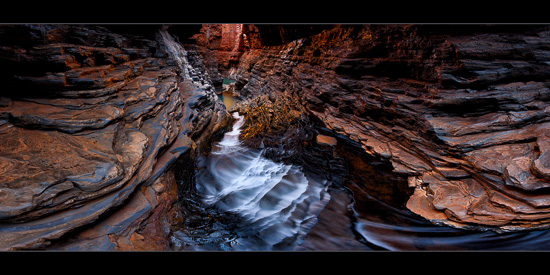Regans Curve…
by Rodney Campbell on Jan.26, 2016, under Life, Photography
My final image from this spot above Regans Pool – a four (4) frame stitched panorama looking down the cascade for an extra wide view. As with some other areas I took each of the four frames as a sequence of three bracketed exposures (-1 & 2/3EV, -2/3EV & +1/3EV). In the end I only needed to exposure blend one of these sets (the one looking straight ahead), for the rest the single -2/3EV exposure was fine.
Regans Curve
Note: These images (especially the wider shots) look much better when larger – so click any of the images below to see larger versions in an inline overlay slideshow gallery viewer.
Pro Tip: I didn’t end up using many of my normal landscape filters (GND or ND) very often whilst down in the gorges. Shooting at the times of day (early morning or late afternoon) when the sun wasn’t beaming directly down into the gorges afforded me naturally longer exposures at normal apertures (f/8 to f/16) and ISO’s (near base 100). This meant I could get shutter speeds in the range I wanted to get the sort of flow and structure in the moving water that I wanted without having to use ND filters to extend exposure times. Note however I almost always had my Heliopan 105mm circular polariser on which also provides approximately two stops of light reduction which assisted getting to the longer exposure times.
Pro Tip: A circular polarising (CPL) filter is a must in these environments. With water, wet rocks and pools of water everywhere within these gorges the appropriate use of a CPL can make a huge difference to your images straight out of camera. It’s also hard to explain how much glare there is just on the bare dry rock (it’s been smoothed shiny by millennia of rushing water and the feet of millions of visitors in these narrow gorges). The CPL helps to cut down the glare of even these rocks but you do have to adjust the CPL each time for each shot to get the best effect. When using very wide angles it’s often not possible to get the polarisation effect to work for the whole frame. You may even be forced to take multiple images with different polarisation angles with a view to blending the resulting best areas in post production.
Happy Australia Day!







